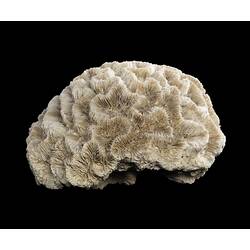Summary
This coral is from the group of corals called brain corals because the sinuous folding shapes of their surface look rather like the surface of a brain. This species, Lobophyllia recta, belongs to a family called the lobo or lobed brain corals. These are stony corals that build a hard skeleton of calcium carbonate. While the hard dry skeleton is all that is seen here, when alive it would have been covered by a colony soft-bodied polyps. When the polyps have their tentacles pulled in most lobo corals look brown or cream but when their tentacles are out to feed they show off a range of colours, from blues and greens to reds, oranges, pinks and purples, often over the same colony. This species would usually be grey, brown and green.
Brain corals are often much more slow growing than staghorn corals and other branched species. Some kinds of brain coral form massive colonies that may be many hundred years old. Thin cores taken from brain coral, which do not harm the colonies, record a history of past environmental conditions on the reef.
This specimen is described as being from "Ocean Island" in the Pacific Ocean, which usually refers to Banaba Island, Kiribati or to Kure Atoll, Hawaii.
Corals are threatened by reduction in reef habitat from climate change and other human impacts as well as the increased likelihood of bleaching events as global average temperature increases. International trade in most corals and coral products is illegal.
Specimen Details
-
Taxon Name
-
Author and date of publication
(Dana, 1846)
-
Preferred Common name
Brain Coral
-
Date Identified
2001
-
Identified By
Dr Carden C. Wallace - Museum of Tropical Queensland
-
Number Of Specimens
1
-
Sex
Unknown
-
Specimen Nature
Form: Dry
-
Category
-
Scientific Group
-
Discipline
-
Collecting Areas
-
Type of Item
Taxonomy
-
Kingdom
-
Phylum
-
Class
-
Subclass
-
Order
-
Family
-
Genus
-
Species Name
recta
Geospatial Information
-
Ocean
-
Precise Location
Ocean Island





